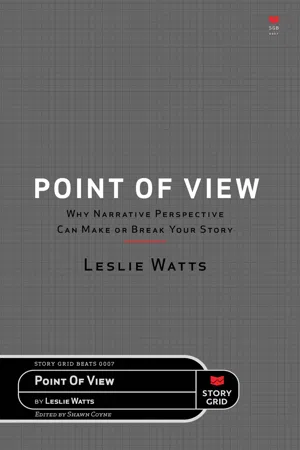Let’s start with the basics. What is point of view?
It’s the technical choice we’re all familiar with—options that are variations on first, second, and third person.
- First Person: I (or we) wrote a story.
- Second Person: You wrote a story.
- Third Person: Alex (or she or he or they) wrote a story.
Any of these point-of-view choices can happen in the past, present, or future.
- Past: I wrote a scene.
- Present: You write (or are writing) a scene.
- Future: Alex will write a scene.
Point of view is also the vantage point from which a story is presented. To deliver a reading experience that satisfies, we must understand both aspects of point of view and how they work together.
What do we mean by vantage point? We might first consider external factors like the place and time where someone stands. Internal factors like the language a person speaks or the beliefs they hold about themselves and the world are relevant too. This is what we mean when we say the villain is the hero of their own story. From their perspective, they aren’t doing anything wrong. In fact, they’re doing the world a favor by dealing with that troublemaker claiming to be a hero. These external and internal qualities of where you stand (or take a stand) determine what you can perceive and the story you tell about it.
What’s fascinating is that you can use the same setting, characters, and events to craft very different stories depending on the vantage point from which it’s presented. For example, if you want to tell a story from a criminal’s point of view, the master detective subgenre of Crime Story (like Murder on the Orient Express by Agatha Christie) wouldn’t be your first thought. You might choose the prison subgenre (like Rita Hayworth and Shawshank Redemption by Stephen King), or a heist (like Ocean’s Eleven), or a caper (like Get Shorty by Elmore Leonard). When you change the vantage point, you change the story, its message, and as a result, the events and circumstances that matter.
The specificity of a story’s vantage point is the reason we can’t change the technical point of view by changing the pronouns. In fact, the vantage point should inform our decision to write in first-, second-, or third-person point of view. Not the other way around. For example, if we’re writing from the vantage point of the protagonist, as in To Kill a Mockingbird (Worldview), first-person point of view makes the most sense. If we want to write a story that employs multiple perspectives, as in The Heart Is a Lonely Hunter by Carson McCullers (Worldview), some form of omniscient narration is often a better choice.
With these thoughts on vantage point in mind, let’s look at the main point of view options from a fresh perspective. First, we need to break them into two groups based on showing and telling. For the moment, forget the advice to “show not tell” because that’s not what we’re getting at here. When it comes to point of view, the categories are about the way we present the story through the effect we create rather than a technique found in a particular passage.
Telling comes to the reader through a narrator. It’s as if someone or something is collecting, collating, and sharing the events and circumstances of the story. We hear about what happens from someone who is communicating with someone else. Showing is more immediate and recreates the effect of being present and observing the events for ourselves. Either option can be conveyed through first-, second-, or third-person point of view.
We’ll start with the point of view types in which a narrator tells the story.
